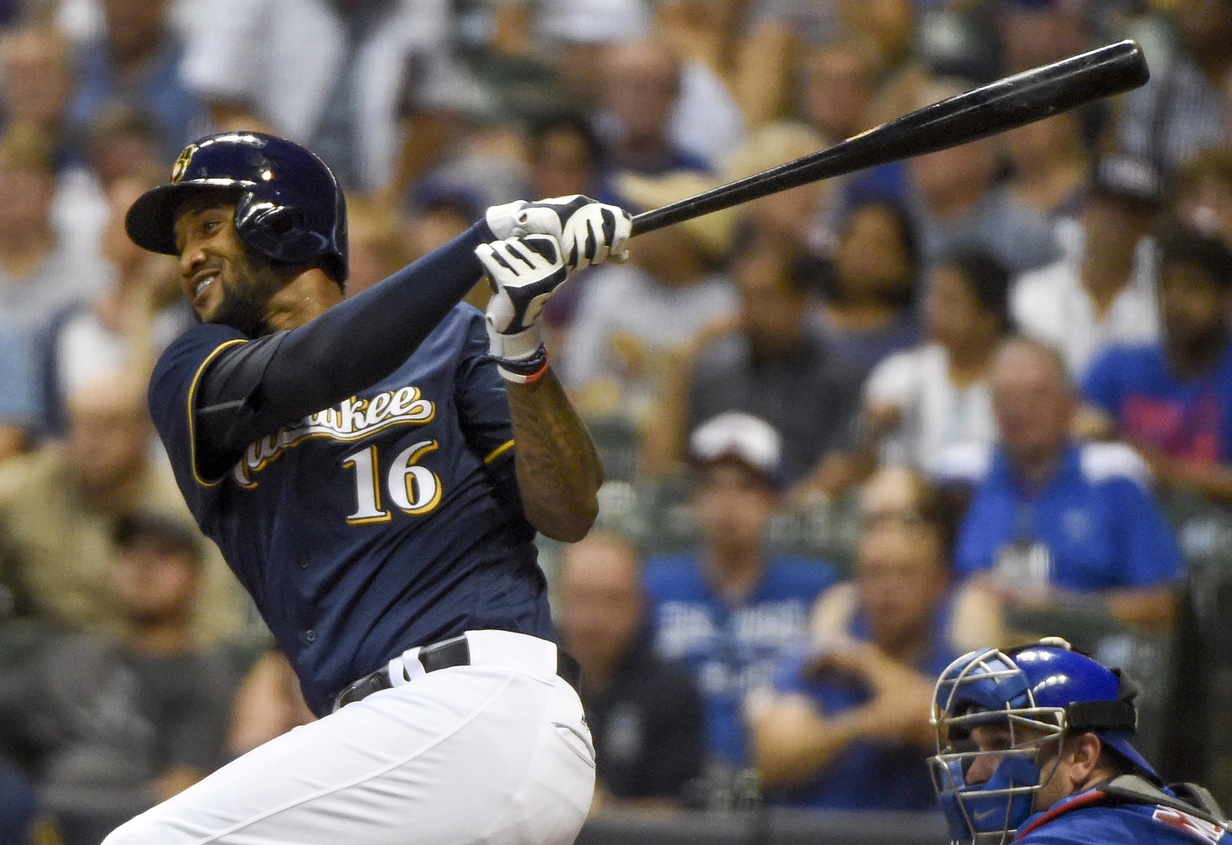When the 2016 season began, Domingo Santana’s stock was rising. He had been acquired in the middle of the season as a key part of the Mike Fiers/Carlos Gomez trade, and his cup of coffee with the Brewers was successful. He posted a .299 TAv in 38 games with Milwaukee after his call-up, and he handled himself reasonably competently in center field. He looked to have a decent shot at locking down a corner outfield spot going forward.
And at the start of 2016, that trend looked to be continuing. Santana started consistently in right field for the first month-and-a-half, and he was serviceable in that time (.734 OPS). Clearly, the club would have been hoping for a more powerful start, but he wasn’t so disastrous that his future was in danger.
But then he suffered back-to-back injuries, first hitting the disabled list with a shoulder problem in mid-May, and then returning to the shelf with an elbow issue in early June. He missed a bunch of games in the middle of the season, and during that time, the Brewers shifted course. Kirk Nieuwenhuis and Hernan Perez played a lot of right field, and Keon Broxton took over from Nieuwenhuis in center field.
If the Brewers had their druthers, perhaps only Broxton would be the one standing in the way of playing time for Santana. Nieuwenhuis is a journeyman who has been serviceable but not outstanding this year, and Perez is more of a utility player than a full-time outfielder. Neither is particularly essential to the club’s long-term plans, so there will be no hesitation in shunting either of them aside for someone with more potential.
Broxton’s existence and breakout is relevant because it removes an outfielder spot from contention, but Santana playing in center again was unlikely. Despite his relatively successful stint there at the end of 2015, he is a corner outfielder. The month in center field was to give him some additional experience and test his boundaries a bit, but his future is in a corner—and, as long as Ryan Braun remains on the Brewers and ambulatory, that corner will be right field.
However, Santana’s presence in the Brewers’ long-term plans is not as assured as it may have seemed at the beginning of this season. When the most recent memory was of him being in the lineup every day for a month and producing, he seemed a lot more integral than he does after being out for a couple months, and this leads to a reevaluation of his place.
First, he is not a center fielder, and the Brewers still have Ryan Braun. While an offseason trade of the face of the organization is possible, it does not seem likely at this moment. This means that there is one spot for Santana to fit into. This was also the case at the beginning of this year, but that wasn’t as much of an issue because there simply wasn’t as much competition as there is now. Santana could slot easily into right field because his competition was Rymer Liriano; center field was open and being held for Brett Phillips, but it offered the possibility of playing time for Santana if necessary.
Now, though, the organization has drastically upgraded its outfield options. Broxton, who was acquired last offseason but was an unknown quantity, has improved significantly this year. His exit velocity (and other improvements) has been noteworthy, and his results have matched to the tune of a .278 TAv. His exact big league trajectory is still unclear, but he appears to be headed for a future as at least a fourth outfielder, and his ability to play center field puts him a step above Santana in terms of roster building.
Brett Phillips and Lewis Brinson are also complicating factors. Phillips looked like the favorite to be the starting center fielder on the next good Brewers team, but the acquisition of Brinson in the Jonathan Lucroy deal has complicated that slightly. Brinson was a top-25 prospect in the midseason rankings update, and he likely isn’t far away from the big leagues given that he spent the season splitting time between Double-A and Triple-A. Phillips, meanwhile, is still promising but has some work to do to beat out Broxton (who performed in the big leagues) and Brinson (who has the richer pedigree).
All of this combines to make Santana’s job difficult. Basically, he needs to hit. With an outfield crunch coming, Santana needs to differentiate himself—and he can! It is important to remember that there were reasons to be excited about him. An injury-plagued year has removed some of the luster, but he is still a young player (having just turned 24 years old) and perfectly capable of bouncing back next year. If he reaches his potential, he brings a skillset that those other young outfielders don’t.
Young, unproven players who have injury-plagued seasons often get forgotten, and that has kind of occurred here. However, the changes in the organizational depth chart also make Santana’s path a little less clear. All that means, though, is that he has to prove himself, and that’s what major league baseball teams want to force their players to do: earn their spots. If Santana cannot do that, the team has other options. If he can, though, he will solidify his spot in right field.
